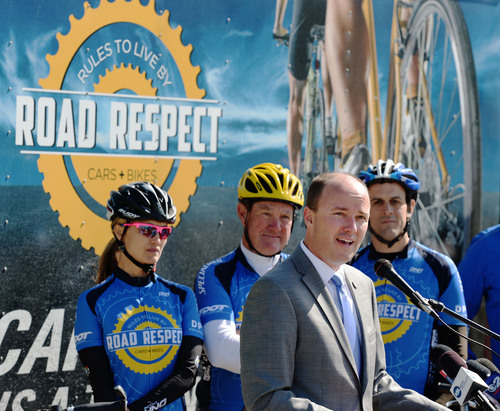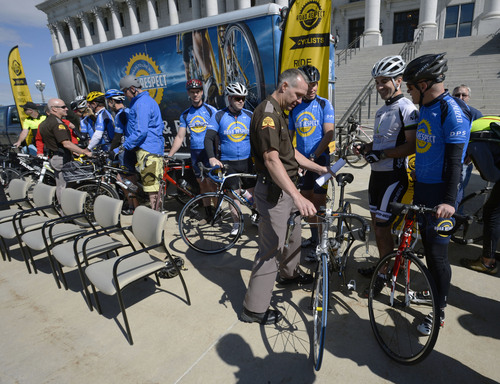This is an archived article that was published on sltrib.com in 2014, and information in the article may be outdated. It is provided only for personal research purposes and may not be reprinted.
He once was intentionally run off the road while bicycling. Motorists threw water bottles and junk at him, and yelled simply because he was cycling on the road. He's been hit more than once by careless drivers.
With all that, Utah Senate President Wayne Niederhauser, an avid cyclist, said things seem to be improving.
"There is more respect and I feel safer on the road today" because of new laws and education campaigns by the state in recent years, the Sandy Republican said Monday as he helped kick off the state's fourth annual Road Respect tour to build awareness of cycling laws.
Lt. Gov. Spencer Cox told a crowd at the state Capitol that in three years, Utah has improved from No. 31 to No. 8 in rankings of bicycle-friendly states, according to the League of American Bicyclists.
New laws last year more clearly stated that motorists had to give at least three feet of space to cyclists and banned distracting cyclists to cause harm — which had been a problem, as people had honked, yelled and even slapped them from moving vehicles.
A new law last year also allows motorists to cross the center line when passing a cyclist, even a double-yellow line, as long as it is safe to do so.
Niederhauser noted that the Road Respect tour aims to educate motorists to treat cyclists better, but also teaches cyclists to respect motorists — and he figures a lot of the abuse he suffered through the years came from motorists who were frustrated at other inconsiderate cyclists.
"If you make motorists angry, they will take it out on any cyclist," Niederhauser said. "So please be respectful, cyclists, when you are out on the road."
Cox said, "There is definitely room for all of us on these roads."
The tour this year will include seven rides and community events — with free food and information — in coming weeks, from St. George to Logan. A schedule and details are available online at RoadRespect.Utah.gov.
Carlos Braceras, executive director of the Utah Department of Transportation, also an avid cyclist, said UDOT, too, is taking steps to make highways safer for cyclists — such as including bike trails and lanes in new projects.
The state is upgrading many of its traffic signals so they will detect cyclists — not just cars — and change lights to allow them to proceed safely.
In addition, UDOT's traffic app has a section for cyclists that contains such information as shoulder width and daily traffic for highways "so you can make a decision when you are planning your rides on 'Is that shoulder wide enough, or is there too much traffic for me to choose to want to cycle down that roadway?' " Braceras said.
In the past 10 years, he said, 55 cyclists have been killed on Utah roads and another 746 were involved in serious-injury accidents. House Speaker Becky Lockhart, R-Provo, urged all road users to "make a commitment to be aware of each other … because everyone's lives really do depend on it."
Phil Sarnoff, executive director of Bike Utah, a cycling advocacy group, said cycling brings many benefits, from reducing air pollution to cutting congestion and wear and tear on roads.
"One car has the same impact on a street as 9,600 bicycles," he said. "Traffic flows more smoothly when people ride bikes because there are fewer cars to create congestion."
Cycling has become more popular in recent years in Utah. The U.S. Census reported last week that residents in Salt Lake City, Provo and Logan are four to seven times more likely than typical Americans to bike to work.
Still, only a tiny fraction of them do so — 4.1 percent of workers in Logan, 3.1 percent in Provo and 2.5 percent in Salt Lake City, according to a report released Thursday.

















